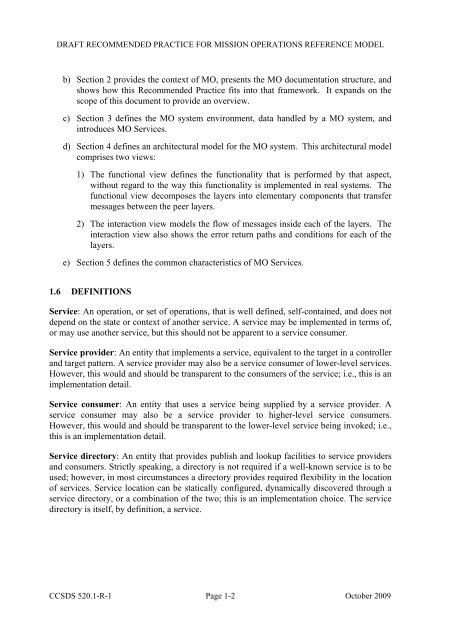Mission Operations Reference Model. Draft ... - CCSDS
Mission Operations Reference Model. Draft ... - CCSDS
Mission Operations Reference Model. Draft ... - CCSDS
Create successful ePaper yourself
Turn your PDF publications into a flip-book with our unique Google optimized e-Paper software.
DRAFT RECOMMENDED PRACTICE FOR MISSION OPERATIONS REFERENCE MODELb) Section 2 provides the context of MO, presents the MO documentation structure, andshows how this Recommended Practice fits into that framework. It expands on thescope of this document to provide an overview.c) Section 3 defines the MO system environment, data handled by a MO system, andintroduces MO Services.d) Section 4 defines an architectural model for the MO system. This architectural modelcomprises two views:1) The functional view defines the functionality that is performed by that aspect,without regard to the way this functionality is implemented in real systems. Thefunctional view decomposes the layers into elementary components that transfermessages between the peer layers.2) The interaction view models the flow of messages inside each of the layers. Theinteraction view also shows the error return paths and conditions for each of thelayers.e) Section 5 defines the common characteristics of MO Services.1.6 DEFINITIONSService: An operation, or set of operations, that is well defined, self-contained, and does notdepend on the state or context of another service. A service may be implemented in terms of,or may use another service, but this should not be apparent to a service consumer.Service provider: An entity that implements a service, equivalent to the target in a controllerand target pattern. A service provider may also be a service consumer of lower-level services.However, this would and should be transparent to the consumers of the service; i.e., this is animplementation detail.Service consumer: An entity that uses a service being supplied by a service provider. Aservice consumer may also be a service provider to higher-level service consumers.However, this would and should be transparent to the lower-level service being invoked; i.e.,this is an implementation detail.Service directory: An entity that provides publish and lookup facilities to service providersand consumers. Strictly speaking, a directory is not required if a well-known service is to beused; however, in most circumstances a directory provides required flexibility in the locationof services. Service location can be statically configured, dynamically discovered through aservice directory, or a combination of the two; this is an implementation choice. The servicedirectory is itself, by definition, a service.<strong>CCSDS</strong> 520.1-R-1 Page 1-2 October 2009
















